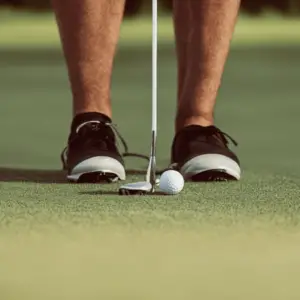Last Updated on May 31, 2023
Golf is a game of precision and accuracy, and learning how to aim in golf plays an important role. Achieving the perfect shot requires practice, patience, and dedication – but it all starts with mastering your stance for accurate aiming. From focusing on alignment to developing a pre-shot routine that works best for you, there are many techniques you can use to improve your ability when it comes to aiming in golf. Learn how these tips will help you get better at this complex yet rewarding sport.
Table of Contents:
- Master Your Stance for Accurate Aiming
- Focus on Alignment for Consistent Aiming
- Develop a Pre-Shot Routine for Improved Aiming
- Practice Visualization Techniques for Better Aiming
- Understand the Impact of Wind Direction on Aiming
- Conclusion
Master Your Stance for Accurate Aiming
A proper stance is essential for accurate aiming in golf. Position your feet apart, parallel to the target line, with shoulders-width as a measure. Your weight should be evenly distributed on both feet, with your left foot slightly ahead of the right if you’re a right-handed golfer. It’s important to maintain a comfortable posture throughout your swing so that you don’t put any extra strain on your back or shoulders. Keep your arms at a comfortable distance apart, not too close together; having them spread out will help maintain balance while swinging.
Proper stance and alignment are essential for accurate aiming in golf. With the right focus, you can master these two elements to ensure a consistent aim every time. Next, we will discuss how to focus on alignment for improved accuracy when aiming your shots.
Focus on Alignment for Consistent Aiming
Aligning your body and clubface is essential for consistent aiming. Proper alignment gives you the best chance of hitting the ball in the direction that you intended. Here are some suggestions to help you ensure proper alignment:
1. Set Up Position – Start by standing behind your ball, feet shoulder-width apart, with a slight bend at the knees and hips. Make sure your weight is evenly distributed between both legs, and keep your head still throughout the swing.
2. Shoulder Alignment – Once in position, focus on aligning your shoulders parallel to where you want to hit the ball; this will give you a good base from which to start your swing motion. Keep an eye out for any signs of swaying or sliding during setup, as these can cause inconsistencies when aiming later on in the shot process.
3. Clubface Alignment – Now it’s time to check that all parts of your clubface are pointing directly towards where you want to aim (the target). This means checking that not only is it facing straight ahead but also making sure there’s no twist or tilt present either side-to-side or top-to-bottom before starting backswing motion too soon.

With a firm but gentle grip, make sure to maintain just the right amount of pressure so that when you release after impact, you can still maintain control over accuracy without feeling overly strained from tension build up. Keep an eye out for any signs of swaying or sliding during setup and avoid overcompensating due to lack of feel for proper alignment.
By following these steps carefully each time before taking a shot, consistency should become second nature while aiming correctly with greater ease than ever before. After all, practice makes perfect, so why not get started today?
Focusing on alignment is an important part of consistently aiming correctly. By developing a pre-shot routine, you can further improve your accuracy and aim with each shot.
Develop a Pre-Shot Routine for Improved Aiming
Having a pre-shot routine is essential for improving your aiming accuracy. Staying concentrated and giving yourself the best opportunity to hit your target each time is essential for improving accuracy. The first step in developing a pre-shot routine is to focus on alignment. Alignment refers to setting up your body and club correctly so that when you swing, the ball will go where it’s supposed to. To ensure proper alignment, take some practice swings with no ball and check that your feet, hips, shoulders and eyes are all pointing towards the target line.
Next, concentrate on mastering your stance before taking each shot. Your stance should be comfortable but also provide stability while swinging through the ball. Make sure your feet are slightly wider than shoulder width apart and point them at an angle just outside of parallel with each other; this will help keep you balanced throughout the swing motion. Keep in mind that if either foot slips during or after impact, then it can affect where the ball goes – “A slip of the foot means a slip of direction”, as they say.
Once you have mastered both alignment and stance, then it’s time to develop a mental approach for each shot by visualizing what needs to happen before taking action. Visualization involves picturing yourself executing perfect shots in order to increase confidence levels which can lead to better results out on the course – “Seeing is believing”. Before beginning any swing sequence, close your eyes briefly (or longer if needed) while imagining exactly how everything should feel like from the start right through until the finish; make sure every detail has been accounted for, such as backswing length/width, arm extension etc. Doing this regularly can really improve overall performance over time too.
Finally, remember not to forget about wind direction as this could drastically alter where balls end up flying off towards due its effect upon trajectory; aim higher into headwinds or lower into tailwinds depending on what type is present at any given moment – “When there’s wind around think ahead”. All these steps combined create an effective pre-shot routine which, once perfected, provides golfers with increased accuracy when aiming for targets out on the course – “Practice makes perfect.”
Developing a pre-shot routine can help you focus and improve your aim on the golf course. Visualizing can help sharpen your targeting ability, thus enabling you to become a more proficient golfer.
Practice Visualization Techniques for Better Aiming
Accuracy and precision in golfing can be improved through the use of visualization techniques. It’s a technique that can help you focus on the target and visualize where your shot will land. Gaining proficiency in this skill necessitates comprehension of its operation and consistent rehearsal.
First, focus on alignment when practising visualization techniques. To ensure accuracy, it is essential to make sure that all of your joints are aligned correctly prior to each swing. Take some time before each swing to ensure that all of your joints are aligned properly so that when you take the shot, everything is in sync.

Next, develop a pre-shot routine for improved aiming. This means taking a few moments before every shot to assess the situation: what’s my stance? What club am I using? Where do I want my ball to land? Figuring out what club to use and where you want the ball to land can help focus your attention and improve shot accuracy.
Thirdly, use visualization techniques during practice rounds or while playing competitively. Visualize yourself swinging correctly and hitting the ball exactly as planned; see yourself making good contact with the club head at impact; envision a perfect trajectory towards its destination – all these steps will help increase confidence which leads directly to better aim.
Finally, be aware of wind direction when visualizing shots – even slight changes in wind speed or direction can have an effect on flight paths, so keep this factor in mind while plotting out trajectories mentally or physically, marking them down on paper beforehand (if possible). If there’s no way around it, then just “gut it out”, like they say: take one deep breath and trust that everything will work out fine.
Understand the Impact of Wind Direction on Aiming
Wind direction can have a huge impact on your aim when playing golf. It is important to understand how wind direction affects the flight of the ball and how you can adjust your stance and swing accordingly.
Alignment
The most important factor in adjusting for wind direction is proper alignment. When facing the wind, you should align yourself so that your body faces slightly away from it. This will help reduce the effect of the wind on your shot, as well as make sure that you are still hitting straight towards your target.
Stance
Your stance should also be adjusted based on which way the wind is blowing. If it’s coming from behind you, take a wider than normal stance to give yourself more stability against its force; if it’s coming from in front of you, try narrowing it up to keep balance while swinging through it. Additionally, opening or closing up depending on where the wind is coming from can also help with accuracy and control over distance shots.
Pre-Shot Routine
Developing a pre-shot routine before each shot will help ensure consistency in aiming regardless of conditions such as wind speed or direction changes during playtime. Taking practice swings at different angles can prepare you for any situation by allowing an adjustment period between shots and giving time to focus on controlling contact points throughout each swing motion – this means better accuracy even when faced with unpredictable winds.
Conclusion
In conclusion, improving your aim in golf is a process that requires practice and dedication. Taking the time to master your stance, focus on alignment, develop a pre-shot routine, practice visualization techniques and understand how wind direction affects aiming will help you become an accurate golfer. With patience and perseverance, you can improve your aim in golf games significantly.



